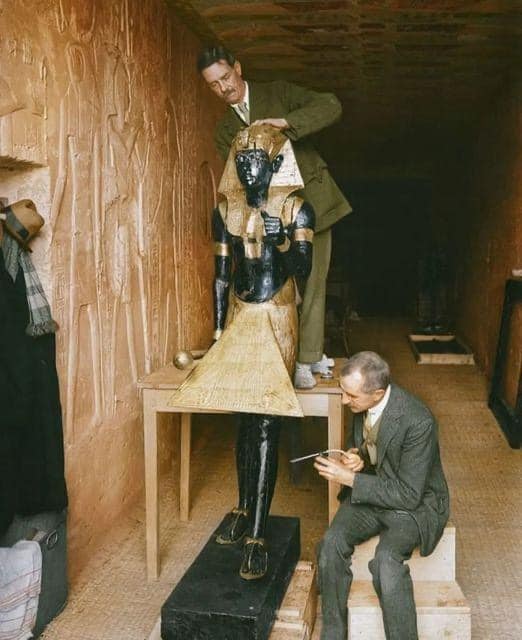In January 1924, a transformative moment in archaeology unfolded within the tomb of Sethos II, identified as KV 15. A colorized photograph from that period captures two prominent archaeologists, Arthur Mace and Alfred Lucas, deeply engrossed in their conservation work. Mace, standing, and Lucas, seated, are shown in a makeshift ‘laboratory’ within the Antechamber of the tomb. Their focus was on preserving two sentinel statues (Carter no. 22), one of which depicted the young King Tutankhamun. This statue, a striking representation of the boy king, features the iconic nemes headdress, a kilt, and sandals, while the figure holds a mace and staff, symbols of royal authority and protection.

The discovery of King Tutankhamun’s tomb stands as one of the most significant milestones in the history of archaeology. Unearthed in November 1922 in the Valley of the Kings, this remarkable find was led by British archaeologist Howard Carter. Unlike many tombs that had been raided over the centuries, Tutankhamun’s burial site was remarkably intact. It housed an extraordinary array of artifacts, ranging from everyday objects to items of unparalleled opulence. These treasures offered unparalleled insights into ancient Egyptian funerary practices and the life of the pharaohs of the 18th Dynasty.
The tomb of King Tutankhamun holds an exceptional place in the study of ancient Egypt. Beyond its breathtaking contents, the tomb provides valuable historical context about Tutankhamun’s short reign. Ascending to the throne as a child, his rule coincided with a pivotal period marked by religious and political shifts. Artifacts from the tomb reflect the richness of Egyptian culture, the complexity of their governance, and the intricate belief systems that shaped their society. Tutankhamun’s burial goods symbolize not just his royal status but also the artistry and spiritual beliefs that defined his era.
A defining aspect of this historic excavation was the conservation efforts undertaken by the team of archaeologists. Mace and Lucas, as depicted in the photograph, played a vital role in ensuring that the artifacts were carefully preserved for future generations. Working in challenging conditions, they demonstrated meticulous care and expertise. The importance of their efforts cannot be overstated; without their diligence, the fragile treasures might not have survived to the present day. Their work exemplified the critical role of conservation in archaeology, ensuring that these relics of the past could be studied, appreciated, and admired by future scholars and the public.
Among the treasures discovered were the sentinel statues, which have captivated audiences with their intricate craftsmanship. These statues, placed as guardians of the tomb, reflect the artistic achievements and symbolic traditions of ancient Egypt. The depiction of Tutankhamun in these works underscores the dual nature of the pharaoh—as both a divine figure and a mortal leader. The precision and care taken in crafting these statues highlight the dedication of Egyptian artisans to their craft and their culture’s enduring emphasis on symbolism and legacy.
The ongoing study and exhibition of the artifacts from Tutankhamun’s tomb continue to captivate audiences worldwide. Many of the most iconic pieces, including the golden mask and other burial items, are housed in the Egyptian Museum in Cairo, where they draw visitors eager to connect with this extraordinary chapter of history. These treasures have also traveled internationally, allowing people from across the globe to experience the wonders of ancient Egypt firsthand. Exhibitions featuring Tutankhamun’s artifacts provide an immersive glimpse into the grandeur of his time, showcasing the sophistication and spiritual depth of his civilization.
This colorized photograph from January 1924 is more than just an image; it is a visual record of a pivotal moment in the preservation of history. The dedication of Mace, Lucas, and the entire team of archaeologists serves as an enduring reminder of the value of conservation in the field of archaeology. Their work ensured that these treasures could transcend time, allowing them to inform and inspire future generations about the grandeur and complexity of ancient Egypt.
The impact of King Tutankhamun’s tomb extends far beyond the artifacts themselves. The discovery has profoundly influenced our understanding of ancient Egyptian society. The tomb’s contents shed light on the daily lives, religious practices, and political dynamics of the time. Moreover, the story of the tomb’s discovery continues to inspire new generations of archaeologists, historians, and enthusiasts. It remains a testament to the richness of ancient Egyptian culture and its ability to fascinate and educate audiences across the globe.
The legacy of Tutankhamun is one of timeless intrigue and fascination. Nearly a century after its discovery, his tomb continues to spark curiosity and admiration. The intricate artistry, the symbolism embedded in each artifact, and the historical insights derived from them make this one of the most significant archaeological discoveries in history. Today, the treasures from Tutankhamun’s tomb stand not only as relics of a bygone era but as bridges connecting modern audiences to the distant past.
The work conducted within the tomb of Sethos II in 1924, as captured in this photograph, underscores the importance of preserving humanity’s cultural heritage. Each artifact holds a story—a glimpse into the lives, beliefs, and aspirations of the people who created and revered them. The efforts of Mace and Lucas remind us that archaeology is not just about discovery but also about stewardship, ensuring that the past is protected for the enrichment of the future.
This iconic colorized image symbolizes the enduring legacy of King Tutankhamun and the civilization he ruled. It serves as a reminder of the importance of history and the value of preserving cultural heritage. As we continue to explore and learn from ancient civilizations, the story of Tutankhamun’s tomb remains a cornerstone in our understanding of human history, bridging the past with the present and inspiring the future.





